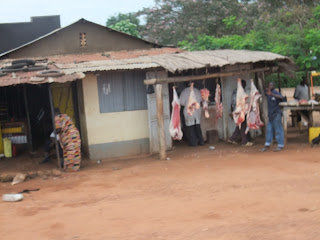We captured the next minutes of our visit on video. Here's what you'll see:
The first batch of kids is the welcoming committee - what a reception! Notice (as the camera points up the road) the dancers leading the way to the church.
The second part of this video shows a group of kids dancing on the church's platform. Most of these children are orphans. Because they were so poor, they were wondering what they could offer to God. Finally, they decided they could dance and sing for Him! The result is what you see on the video. (Check out the little boy in the front row - he is REALLY into it!)
The words to their song are: "Things already better, when the Lord is on my side, things already better." I hope you enjoy it as much as we did - what a testimony by these kids! The words take on a new meaning when you remember the children are orphans, living in a very poor area. They are learning that there is hope when they have Jesus! And God has used them in a big way - they have traveled to Nairobi, Kenya and to Rwanda to minister with Gospel music.
(NOTE: The above version is not HD - If you want to watch this in the full-screen version, use the following link to get good resolution: |
In case you were wondering why we were talking about churches in a blog about our Compassion trip - it's because Compassion does all their work by partnering with churches. The community does not see Compassion International - instead, they only see the church being Christ to the community.
Often a church in a developing country has a real heart for ministering to children in extreme poverty, but it lacks the required resources. So churches and Compassion work in partnership - Compassion provides curriculum, training, etc. so the church can establish an effective, Christ-centered child development program. Compassion also provides funding (via child sponsorships) which is used to minister directly to the sponsored children. And if the church encounters a major roadblock in caring for the children, the church and Compassion work together clear them. For example, if one of the children requires major medical care, Compassion may arrange transportation and pays the cost of the care at an appropriate facility. If the the child's caregiver cannot provide safe housing, Compassion may provide the resources for the church to construct a proper house.
 |
IN OTHER WORDS, Compassion connects Christians like you and me with churches in areas of extreme poverty. When I sponsor a child, I enable that church to minister directly to "my" child. And I also minister to that child, as I develop a relationship with him or her. In a future blog, I'll share what sponsor kids told us they think about their sponsors.....
But for now, enjoy some more pictures of our visit that first day! I hope you enjoy them as much as the children enjoyed having their pictures taken, and then seeing themselves on the digital camera. EVERYBODY had to get in on the act!
But for now, enjoy some more pictures of our visit that first day! I hope you enjoy them as much as the children enjoyed having their pictures taken, and then seeing themselves on the digital camera. EVERYBODY had to get in on the act!
 |
| A Sobering Reminder of One of the Challenges (HIV/AIDs) |







































